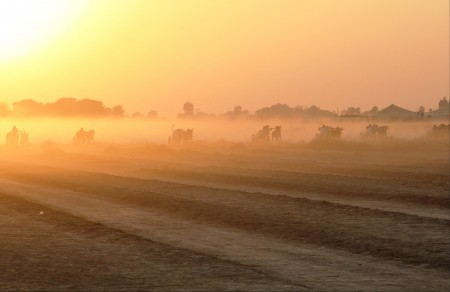This wonderfully evocative piece on ox-cart racing in Pakistan was originally posted to DAD-Net by Dr M. Sajjad Khan, professor in the Department of Animal Breeding & Genetics at the University of Agriculture, Faisalabad, Pakistan. It is reprinted here, along with a photograph of the event, by kind permission of the author. Our thanks to him, and our best wishes for his work.
I thought to share a very learning experience of organizing (more correctly, witnessing) an ox-race competition. The competition was organized in connection with University’s golden jubilee celebrations this year at one of the sub-campuses of the University (Toba Tek Singh), some 90 km from Faisalabad and 200 km from Lahore, the capital of Punjab province. This was part of the Technology Transfer Day and Kissan Mela. I had seen a few ox-related competitions before, including fast ploughing, load pulling, circular speeding, speed threshing, ox-walk etc etc. This was ox-cart racing.
Some 60 ox-pairs (with cart behind), driven by an experienced rider, competed in 10 heats and a final. There were no written rules but everybody understood them. Judges did not have any special uniform but their decisions were final. No grass on the ground. No pistol and no flag at the starting point, just a call by the starter (who has been doing this since his teenage years). No lines except the finish line (marked by white lime powder and redrawn just before the final, the eleventh race). No police to control the mob of thousands (all volunteers plus few boy scouts that we had added).
The high ground near the finish line had by this time been covered with tents and chairs for a few of us and for guests (who cannot sit on feet for hours). The ground was some 1540 feet long. The roar of mob indicated that the race had started. Each race lasted for less than a minute, and ended with thousands of people running after the participants. Then one could only hear the loud voice of drums and see the storm of dust moving and settling. The oxen were covered with decorated clothes again. The Rs bills are thrown into the air repeatedly and many dance around the winners. The festivity would continue for about half an hour with the last fifteen minutes also used for reorganizing things for the next heat. Villages were competing with villages, casts with casts, localities with localities, and there were some individual clashes as well. Some of the heats were a photo-finish and a video camera did help to resolve which foot (not nose) touched the white line first.

Two indigenous breeds were generally represented: Hissar (mainly) and Dhann (which is the main breed in such competitions held in northern Punjab). Some were crosses between nondescript Desi and Dhanni. I did chat with at least a few who had been competing for decades. I recall that when I was doing the State of the World report for Pakistan, I thought breeds historically used for ploughing might fade out soon, but now my feeling is that it will take a lot longer than I had thought. People are taking care of some of the indigenous breeds very differently. Most of the bulls had a price tag of a million Rs. Judging for beauty was a challenge but I found many experienced hands helping me to go through it honorably without a feud.
I am really exposed to a new world yet again (after the goat show). Yes, we should encourage these activities and help people to have improved and humane utilization of indigenous resources. At the University, we are likely to develop an ox-cart race track in near future and it will be fun to be part of such festivities.
The photos of the event will be posted on the project website soon.
This beats the devil of of NASCAR!
http://www.youtube.com/watch?v=vh5g2ewdNW4